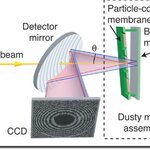Physics

Most continental rocks on Earth align their magnetic moments with the current magnetic field – they are said to have ‘induced’ magnetism. “I consider induced rocks to have ‘Alzheimers’. These are the rocks that forgot where they were born and how to get home,” explains Suzanne McEnroe from the Geological Survey of Norway at a European Science Foundation (ESF), EuroMinScI conference near Nice, France this year.
However, not all of Earth’s continental rocks have an induced magnetization. Some rocks stubbornly refuse to swing with the latest magnetic field, and instead keep hold of the direction…

When most people look at a window they see solid panes of glass but to physicists it isn't so simple. Window glass has always been a puzzle but an Emory University research team led by physicist Eric Weeks has found another clue.
Weeks has devoted his career to probing the mysteries of "squishy" substances that cannot be pinned down as a solid or liquid. Referred to as "soft condensed materials," they include everyday substances such as toothpaste, peanut butter, shaving cream, plastic and glass.
Scientists fully understand the process of water turning to ice.
As the temperature cools, the…

A nuclear physicist from Florida State University collaborated with other scientists from the United States, Japan and England in an experiment that illustrated how the “normal” rules of physics don’t apply for some unstable elements.
Kirby W. Kemper, the Robert O. Lawton Distinguished Professor of Physics and vice president for Research at FSU, took part in an experiment at the National Superconducting Cyclotron Laboratory, a national user facility located at Michigan State University in East Lansing, Mich. In the experiment, Kemper and his colleagues found that the structure of atomic…

Most people think of Sir Isaac Newton as the father of gravity but he also created one of the earliest observations of interference in his “dusty mirror” experiment.
In a darkened room, he used a prism and a small hole in a screen to form a quasi-monochromatic beam from sunlight, which he shone onto a back-quick silvered mirror. The mirror was angled to return the beam back through the hole and on the screen. Newton observed dark and light rings of light, which he found “strange and surprising.”
It was 100 years later when the British scientist Thomas Young determined the rings were caused…

Like navigating spacecraft through the solar system by means of gravity and small propulsive bursts, researchers can guide atoms, molecules and chemical reactions by utilizing the forces that bind nuclei and electrons into molecules (analogous to gravity) and by using light for propulsion. But, knowing the minimal amount of light required, and how that amount changes with the complexity of the molecule, has been a problem.
Now, by creating a quantum mechanical analog of Ulam’s conjecture, researchers at the University of Illinois and the University of California have expanded the flexibility…

The dream of theoretical physics is to unite behind a common theory that explains everything, but that goal has remained highly elusive.
String theory emerged 40 years ago as one of the most promising candidates for such a theory, and has since slipped in and out of favor as new innovations have occurred. Now Europe is fortunate to have one of the world’s leading experts in string theory working on an ambitious project that could make significant progress towards a unified theory, and at least help resolve two mysteries.
One is how the universe emerged in the beginning as a random…

An international research team, led by scientists at the London Centre for Nanotechnology (LCN), has found a way to switch a material’s magnetic properties from ‘hard’ to ‘soft’ and back again – something which could lead to new ways of controlling electromagnetic devices. The research shows how a magnet can be ‘tuned’ by subjecting it to a second magnetic field, perpendicular to the original.
Magnets can be classified by their ‘hard’ or ‘soft’ magnetic properties. Hard magnets, sometimes called ‘permanent’ magnets, have fixed or ‘pinned’ domain walls which mean the material stays magnetised…

An international team of scientists, including several at The Johns Hopkins University, has detected a hidden magnetic “quantum order” that extends over chains of nearly 100 atoms in a material that is otherwise magnetically disordered.
The findings, which are published online today (July 26) in the journal Science, may have implications for the design of devices and materials for quantum information processing, including large-scale quantum computers capable of tackling problems exponentially faster than can conventional computers.
The team’s results are important because they demonstrate…

Physicists at the Commerce Department’s National Institute of Standards and Technology (NIST) have induced thousands of atoms trapped by laser beams to swap “spins” with partners simultaneously.
The repeated exchanges, like a quantum version of swinging your partner in a square dance but lasting a total of just 10 milliseconds, might someday carry out logic operations in quantum computers, which theoretically could quickly solve certain problems that today's best supercomputers could not solve in years.
The atomic dance advances prospects for the use of neutral atoms as quantum bits (qubits…

There are many objects in nature, such as flowers, that are “pre-programmed” to develop into delicate, beautiful and intrically shaped forms. But can this pre-determined process be duplicated by man starting with plain, flat surfaces?
Yes, say Dr. Eran Sharon and his co-workers, Yael Klein and Efi Efrati, at the Hebrew University of Jerusalem Racah Institute of Physics, who have succeded for the first time anywhere in programming polymer sheets to bend and wrinkle by themselves into prescribed structures. Their work was described in the journal Science.
They made flat discs of a soft gel…